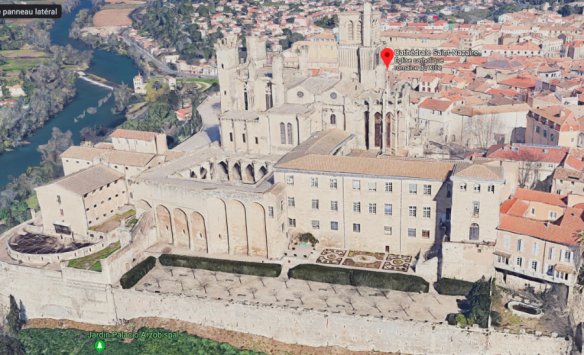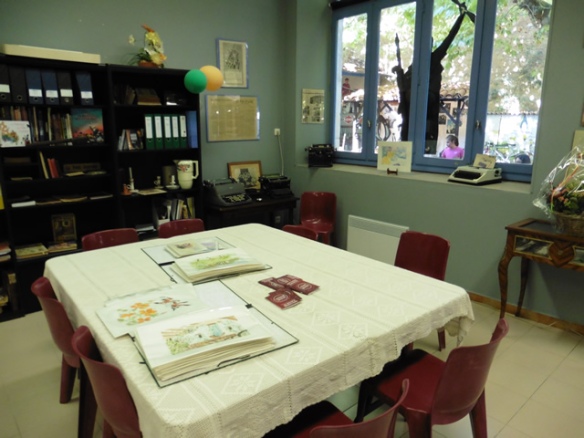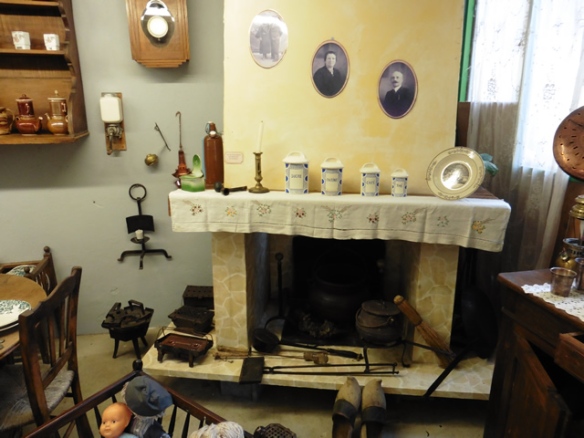This week, I am continuing my series of articles about my visit to Beziers during the recent European heritage days. After visiting the old prison and the cellars below the cloisters, I did not have far to go to my next port of call: the former archbishop’s palace, formerly the Palais de Justice, the court house, and now in a state of limbo.
As it was still drizzling with rain, I did not take any pictures of the outside – I did not have a rain cover for my camera. 😦 . Instead, I’ve been looking at google, and have found some very interesting shots via the street-view and aerial view of google maps.
First, an aerial view of the area around the cathedral. The old prison is to the left and the archbishop’s palace to the right of the cathedral. The little blue Palais de Justice marker indicates the main building and just below it are the gardens, arranged on two terraces and indicated by a green marker.
 Construction of the present building started in the 13th century after the cathedral and palace were destroyed. The palace was rebuilt again in the 17th century in the French manner: a main building flanked by two identical wings around a courtyard. The picture below shows the entrance to the courtyard, which dates from the 18th century:
Construction of the present building started in the 13th century after the cathedral and palace were destroyed. The palace was rebuilt again in the 17th century in the French manner: a main building flanked by two identical wings around a courtyard. The picture below shows the entrance to the courtyard, which dates from the 18th century:
The archbishop’s palace became property of the state during the French Revolution. I’ve not been able to find out what happened to the building from then until 1945, when it became a courthouse. Here is an aerial view of the courtyard:
And this is what the building looks like from the opposite side:
 Inside, the building has undergone many transformations over the centuries. To enter the former palace/courthouse, I climbed a large stone staircase in the courtyard. From a little hallway I went into a large room which took up the whole centre of the building. The walls were decorated with beautiful plasterwork. The ceiling was a la francaise, with large beams topped at a right angle with smaller beams that were placed closely together.
Inside, the building has undergone many transformations over the centuries. To enter the former palace/courthouse, I climbed a large stone staircase in the courtyard. From a little hallway I went into a large room which took up the whole centre of the building. The walls were decorated with beautiful plasterwork. The ceiling was a la francaise, with large beams topped at a right angle with smaller beams that were placed closely together.
From this room, a door gave access to the courtroom. The benches and desks were all still in place, and some people took selfies sitting in the judge’s chair!
Behind the courtroom was a room for the judges to retire to for their deliberations. Two of the walls were lined with very tall bookcases – now empty. The ladder was still in place though and the parquet floor was beautiful.
In one corner of the room, a little door gave access to a tiny room, more of a short corridor really. The building which that room was in protruded from the back of the main building, and from the window I managed to get a nice picture of the garden on the terrace below.
The door at the end of this ‘corridor’ room led to an even tinier room, with a window overlooking the river. If you look closely at the aerial shot earlier in this article, you’ll be able to identify that window!
From the deliberating room, a door next to one of the bookcases led into a dark, bookcase lined passage, and from the passage I entered the courtroom once more. The bookcase was still full of books!! Perhaps they were no longer needed when the court transferred to the new courthouse?
 This is all I was allowed to see of the former archbishop’s palace. The building belongs to the town of Beziers, and plans are afoot to transform it into a museum, where all the collections will be on show together. Currently, the collections are displayed at several different museums in the town. When the new museum is finished, there will be approx. 3000 square metres of exhibition space – still not enough to display everything, apparently!
This is all I was allowed to see of the former archbishop’s palace. The building belongs to the town of Beziers, and plans are afoot to transform it into a museum, where all the collections will be on show together. Currently, the collections are displayed at several different museums in the town. When the new museum is finished, there will be approx. 3000 square metres of exhibition space – still not enough to display everything, apparently!
After that visit I was ready for a spot of lunch!! To be continued…






































































































































































































